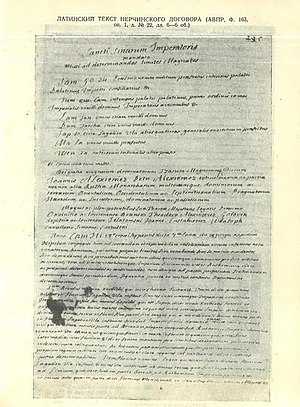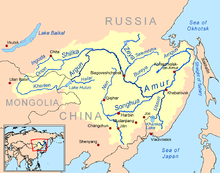 A copy of the Treaty of Nerchinsk in Latin | |
| Type | Border treaty |
|---|---|
| Signed | 27 August 1689 |
| Location | Nerchinsk |
| Expiration | 28 May 1858 |
| Negotiators | |
| Signatories | |
| Parties | |
| Languages | |
| Full text at | |


The Treaty of Nerchinsk of 1689 was the first treaty between the Tsardom of Russia and the Qing dynasty of China after the defeat of Russia by Qing China at the Siege of Albazin in 1686. The Russians gave up the area north of the Amur River as far as the Stanovoy Range and kept the area between the Argun River and Lake Baikal. This border along the Argun River and Stanovoy Range lasted until the Amur Annexation via the Treaty of Aigun in 1858 and the Convention of Peking in 1860. It opened markets for Russian goods in China, and gave Russians access to Chinese supplies and luxuries.
The agreement was signed in Nerchinsk on 27 August 1689.[1] The signatories were Songgotu on behalf of the Kangxi Emperor and Fyodor Golovin on behalf of the Russian tsars Peter I and Ivan V.
The authoritative version was in Latin,[2] with translations into Russian and Manchu, but these versions differed considerably. There was no official Chinese text for another two centuries,[3] but the border markers were inscribed in Chinese along with Manchu, Russian and Latin.[4]
Later, in 1727, the Treaty of Kiakhta fixed what is now the border of Mongolia west of the Argun and opened up the caravan trade. In 1858 (Treaty of Aigun) Russia annexed the land north of the Amur and in 1860 (Treaty of Beijing) took the coast down to Vladivostok. The current border runs along the Argun, Amur and Ussuri rivers.
- ^ Krausse, Alexis Sidney (1899). Russia in Asia: a record and a study, 1558–1899. G. Richards. pp. 330–331. Retrieved 26 August 2011.
- ^ V. S. Frank, "The Territorial Terms of the Sino-Russian Treaty of Nerchinsk, 1689", The Pacific Historical Review 16, No. 3 (August 1947), 265–270. Cited: p. 269: "[...] it appears that according to the Latin text of the treaty (the only valid text!)[...]"
- ^ On the difference between version of the treaty, see V. S. Frank, "The Territorial Terms of the Sino-Russian Treaty of Nerchinsk, 1689", The Pacific Historical Review 16, No. 3 (August 1947), 265–270.
- ^ Journal of the Royal Central Asian Society, 281.